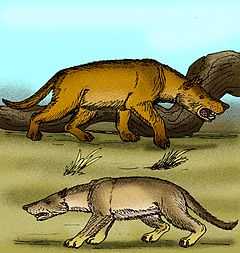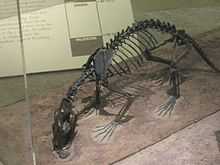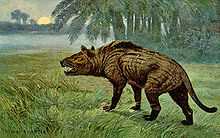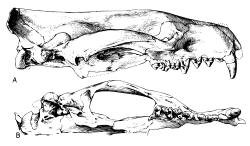Hyaenodontidae
| Hyaenodontidae Temporal range: Late Paleocene–Late Miocene | |
|---|---|
 | |
| Hyaenodon gigas and H. mongoliensis | |
| Scientific classification | |
| Kingdom: | Animalia |
| Phylum: | Chordata |
| Class: | Mammalia |
| Order: | Creodonta |
| Family: | Hyaenodontidae Leidy, 1869 |
| Genera | |
|
See text | |
Hyaenodontidae ("Hyena teeth") is a family of the extinct order Creodonta, which contains several dozen genera.
The Hyaenodontids were important mammalian predators that arose during the late Paleocene and persisted well into the Miocene.[1] They were considerably more widespread and successful than the related oxyaenids.[2]
General Characteristics
Characterized by long skulls, slender jaws, slim bodies, and a tendency to walk on their toes rather than flat-footed (plantigrade), they generally ranged in size from 30 to 140 cm at the shoulder.[2] While Hyaenodon gigas, the largest Hyaenodon species was as much as 1.4 m high at the shoulder, 10 feet long and weighed about 500 kg, most were in the 5–15 kg range, equivalent to a mid-sized dog.[3] Fossil evidence of their skulls shows that they had a particularly acute sense of smell, while their teeth were adapted for shearing, rather than crushing.[2]

Because of their size range, it is probable that different species hunted in different ways and allowed them to fill many different predatory niches. Smaller ones would hunt in packs during the night like wolves, and bigger, fiercer ones would hunt alone during the daylight, using their sheer size and their mighty jaws as their principal weapon. The carnassials in a hyaenodontid are generally the second upper and third lower molars. However, some hyaenodontids possessed as many as three sequential pairs of carnassials or carnassial-like molar teeth in their jaws.[4] Hyaenodontids (like all creodonts) lacked post-carnassial crushing molar teeth (such as those found in many carnivoran families, especially the Canidae and Ursidae), and thus lacked dental versatility for processing any foods other than meat.[5]
Range
Hyaenodontids ranged from North America to Africa,[6][7] and were important hypercarnivores in Eurasia, Africa and North America during the Oligocene, but, lost ground to the carnivoran mammals, with almost the entire family becoming extinct by the close of the Oligocene. Only four genera, Megistotherium, and its sister genus, Hyainailouros, Dissopsalis, and the youngest species of Hyaenodon, H. weilini, survived into the Miocene, of which, only Dissopsalis survived long enough to go extinct at the close of the Miocene.[1]
Genera


- ORDER CREODONTA creodonts
- Family Hyaenodontidae[8]
- Subfamily Hyaenodontinae
- Genus Hyaenodon
- Genus Isohyaenodon
- Genus Metapterodon
- Genus Neoparapterodon
- Genus Pyrocyon
- Subfamily Hyainailourinae
- Genus Akhnatenavus
- Genus Anasinopa
- Genus Apterodon (syn. Dasyurodon)
- Genus Buhakia
- Genus Dissopsalis
- Genus Francotherium
- Genus Hyainailouros (syn. Sivapterodon),
- Genus Megistotherium
- Genus Metasinopa
- Genus Pterodon
- Subfamily Limnocyoninae
- Genus Iridodon
- Genus Limnocyon (syn. Telmatocyon)
- Genus Oxyaenodon
- Genus Prolimnocyon
- Genus Thinocyon
- Subfamily Proviverrinae
- Genus Allopterodon
- Genus Arfia
- Genus Boualitomus
- Genus Cynohyaenodon
- Genus Eurotherium
- Genus Indohyaenodon
- Genus Kyawdawia
- Genus Leonhardtina
- Genus Masrasector
- Genus Paracynohyaenodon
- Genus Paratritemnodon
- Genus Prodissopsalis
- Genus Prototomus
- Genus Proviverra
- Genus Sinopa (syn. Stypolophus, Triacodon)
- Genus Tinerhodon
- Incertae sedis
- Genus Acarictis
- Genus Alienetherium
- Genus Consobrinus
- Genus Galecyon
- Genus Gazinocyon
- Genus Geiselotherium
- Genus Hemipsalodon
- Genus Hyaenodontipus
- Genus Imperatoria
- Genus Ischnognathus
- Genus Leakitherium
- Genus Orienspterodon
- Genus Oxyaenoides
- Genus Paenoxyaenoides
- Genus Parapterodon
- Genus Paravagula
- Genus Paroxyaena
- Genus Praecodens
- Genus Prolaena
- Genus Propterodon
- Genus Proviverroides
- Genus Quasiapterodon
- Genus Quercitherium
- Genus Schizophagus
- Genus Teratodon
- Genus Thereutherium
- Genus Tritemnodon
- Genus Yarshea
- Subfamily Hyaenodontinae
- Family Hyaenodontidae[8]
The Machaeroidinae are sometimes placed here, e.g. by Egi, 2001.[3]
References
- ↑ 1.0 1.1 Barry, J. C. (1988): Dissopsalis, a middle and late Miocene proviverrine creodont (Mammalia) from Pakistan and Kenya. Journal of Vertebrate Paleontology 48(1): 25-45.
- ↑ 2.0 2.1 2.2 Lambert, David and the Diagram Group (1985): The Field Guide to Prehistoric Life. Facts on File Publications, New York. ISBN 0-8160-1125-7
- ↑ 3.0 3.1 Egi, Naoko (2001): Body Mass Estimates in Extinct Mammals from Limb Bone Dimensions: the Case of North American Hyaenodontids. Palaeontology 44(3): 497-528. doi:10.1111/1475-4983.00189
- ↑ Wang, Xiaoming; and Tedford, Richard H. Dogs: Their Fossil Relatives and Evolutionary History. New York: Columbia University Press, 2008. p15
- ↑ Wang, Xiaoming; and Tedford, Richard H. Dogs: Their Fossil Relatives and Evolutionary History. New York: Columbia University Press, 2008. p15-7
- ↑ "HYAENODONTS AND CARNIVORANS FROM THE EARLY OLIGOCENE TO EARLY MIOCENE XIANSHUIHE FORMATION, LANZHOU BASIN, GANSU PROVINCE, CHINA"
- ↑ "New Remains of Hyaenodontidae (Creodonta, Mammalia) From the Oligocene of Central Mongolia"
- ↑ The Paleobiology Database Hyaenodontidae page
| Wikimedia Commons has media related to Hyaenodontidae. |
| Wikispecies has information related to: Hyaenodontidae |
